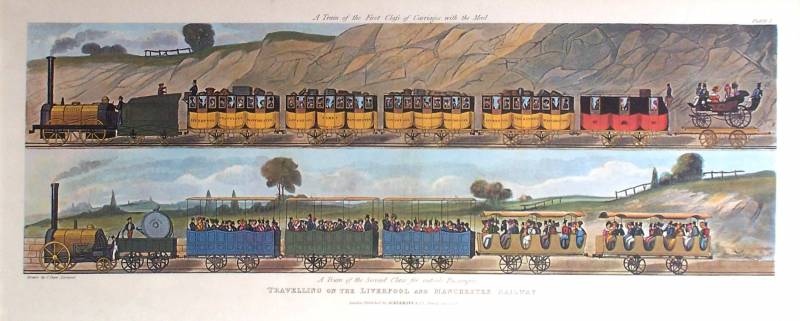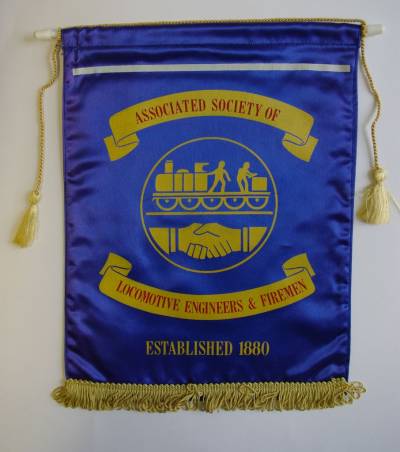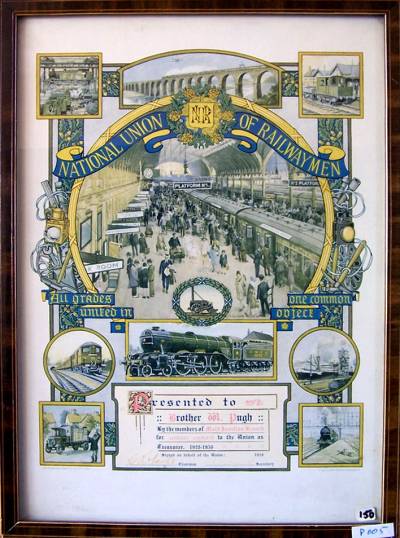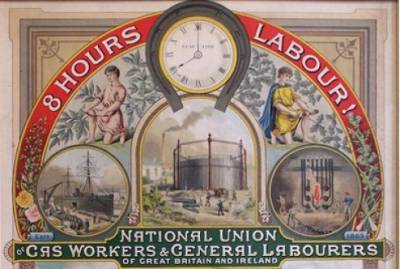In the last 25 years of the 19th century nearly 13,000 railway workers were killed at work. From the start of the development of the railways in the 1830s the question of improving safety - both for passengers and workers - was paramount in the formation of trades unions.

Travelling on the Liverpool and Manchester Railway
From the opening of the Liverpool & Manchester Railway in 1830 (when the local MP was killed on the track) workers attempted to establish forms of combination. In 1836, following the dismissal of a colleague, workers on the Liverpool & Manchester who took strike action in solidarity were found guilty of breach of contract and sentenced to the hard labour of working on a treadmill for six hours a day.
 As the railway network rapidly expanded, workers were often required to work long hours, resulting in a number of major accidents. Although trades unions had been established on a limited basis earlier, the setting up of the Amalgamated Society of Railway Servants (ASRS) in 1871 represented the first attempt to organise nationally. From 1890 to 1913 there were many attempts to bring the ASRS and other unions together to form a general union.
As the railway network rapidly expanded, workers were often required to work long hours, resulting in a number of major accidents. Although trades unions had been established on a limited basis earlier, the setting up of the Amalgamated Society of Railway Servants (ASRS) in 1871 represented the first attempt to organise nationally. From 1890 to 1913 there were many attempts to bring the ASRS and other unions together to form a general union.
By the end of the 19th century railway workers were represented by four other main unions -
- Associated Society of Locomotive Engineers and Firemen (ASLEF) (1879)
- United Pointsmen's and Signalmen's Society (1880)
- General Railway Workers Union (1889)
- Railway Clerks' Association (1897)
Attempts to form a general union were given greater impetus after the various unions worked together to hold the first ever national railway strike in 1911 and the National Union of Railwaymen (NUR) came into being in March 1913. ASLEF, as a craft union, wanted to take part in a much more limited form of federation and remained independent. The Railway Clerks' Association also remained outside of the NUR and was renamed the Transport Salaried Staffs' Association (TSSA) in 1951.
Nevertheless, the NUR was hailed by G.D.H. Cole as ‘a new model as influential for the twentieth century as the Amalgamated Society of Engineers had been for the Victorian age.'
The 1914-1918 War saw the railways being run directly by the Government but by 1919 attempts were made to reduce previously agreed rates of pay and the second national railway strike began in September 1919. David Lloyd George stated that the strike had been ‘engineered by a small but active body of men who wrought tirelessly and insidiously to exploit the labour organisations of this country for subversive ends' but the strike received support on the grounds that the sacrifices of working men were being ignored. ASLEF and the NUR joined together in this dispute and obtained standard national wage rates and, for drivers, an eight hour day.
 The NUR was a member of the Triple Alliance, along with the Miners' Federation of Great Britain and the National Transport Workers Federation, and played an important role in the 1926 General Strike. The creation of four Regions after the First World War was followed by the nationalisation of the Railways through the 1947 Transport Act and the setting up of the British Transport Commission in 1948.
The NUR was a member of the Triple Alliance, along with the Miners' Federation of Great Britain and the National Transport Workers Federation, and played an important role in the 1926 General Strike. The creation of four Regions after the First World War was followed by the nationalisation of the Railways through the 1947 Transport Act and the setting up of the British Transport Commission in 1948.
The Library has a copy of the Beeching Report from 1963 which resulted in drastic cuts to rail services, particularly in rural areas. The era of nationalisation was ended in 1994 with the implementation of a still controversial structure of privatisation contained in the Railways Act 1993. The NUR and the NUS (National Union of Seamen) merged in 1990 to form the National Union of Rail, Maritime and Transport Workers, more generally known as the RMT.
Related Object of the Month
October 2015: Railway strike appeal cards 1933
 These collecting cards belonged to Dick Shaw – ‘Railwayman and Vigilant’ as his grandson described him when he donated the cards to the Library recently. Dick Shaw became an active member of the Railwaymen’s Vigilance Movement in Burnley, and the Library is now very pleased to have been given copies of the movement’s journal Railway Vigilant – including the issue from April 1934 which contains a photo of him when he was standing for the Executive Committee of the ASLEF union as a Vigilant candidate.
These collecting cards belonged to Dick Shaw – ‘Railwayman and Vigilant’ as his grandson described him when he donated the cards to the Library recently. Dick Shaw became an active member of the Railwaymen’s Vigilance Movement in Burnley, and the Library is now very pleased to have been given copies of the movement’s journal Railway Vigilant – including the issue from April 1934 which contains a photo of him when he was standing for the Executive Committee of the ASLEF union as a Vigilant candidate.
Resources about railway workers in the library's collection
The Working Class Movement Library has material on the struggles of the main railway unions throughout the life of the railways and policy documents from the Independent Labour Party, the Labour Research Department, the Communist Party of Great Britain and the rail workers Minority Movement. There are proceedings and reports from the NUR from 1895 to 1987 and photographs, badges and emblems of the union. In addition there are papers and pamphlets relating to ASLEF and TSSA, copies of Railway vigilant: official paper of the Railwaymen's Vigilance Movement from the 1930s, and a very good run of the ASRS, then NUR, weekly journal Railway Review from the 1880s right up until 1969.
The Library holds the two volumes of The Railwaymen: the History of the National Union of Railwaymen by Philip Bagwell (Shelfmark: B47) along with other works by this significant author.
Other Sources
The University of Warwick Modern Records Centre hold the records of the Amalgamated Society of Railway Servants and the General Railway Workers Union which were the forerunners of the NUR, whose records are also held there. Other papers held include the Amalgamated Society of Railway Wagon Builders, Wheelwrights, Carpenters and Mechanics, ASLEF and TSSA.
Papers relating to the NUR and ASLEF are also available at the Labour History Archive and Study Centre at the People's History Museum in Manchester.


